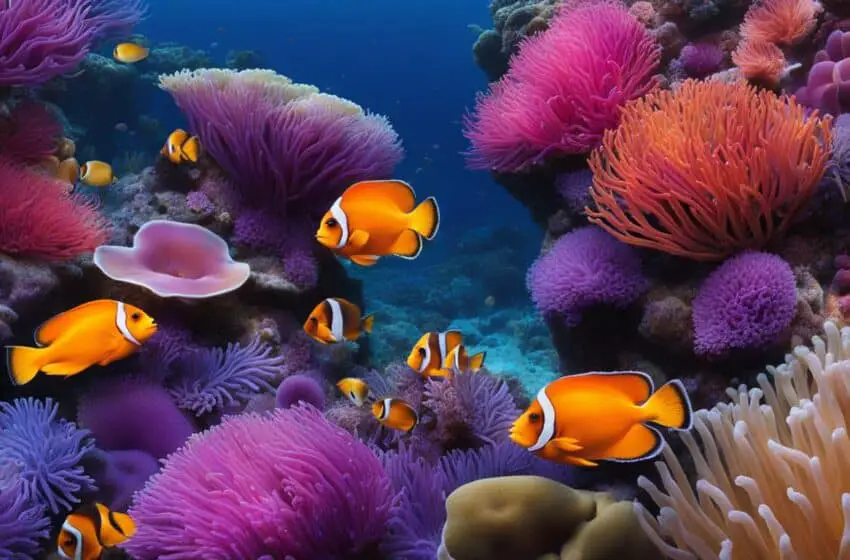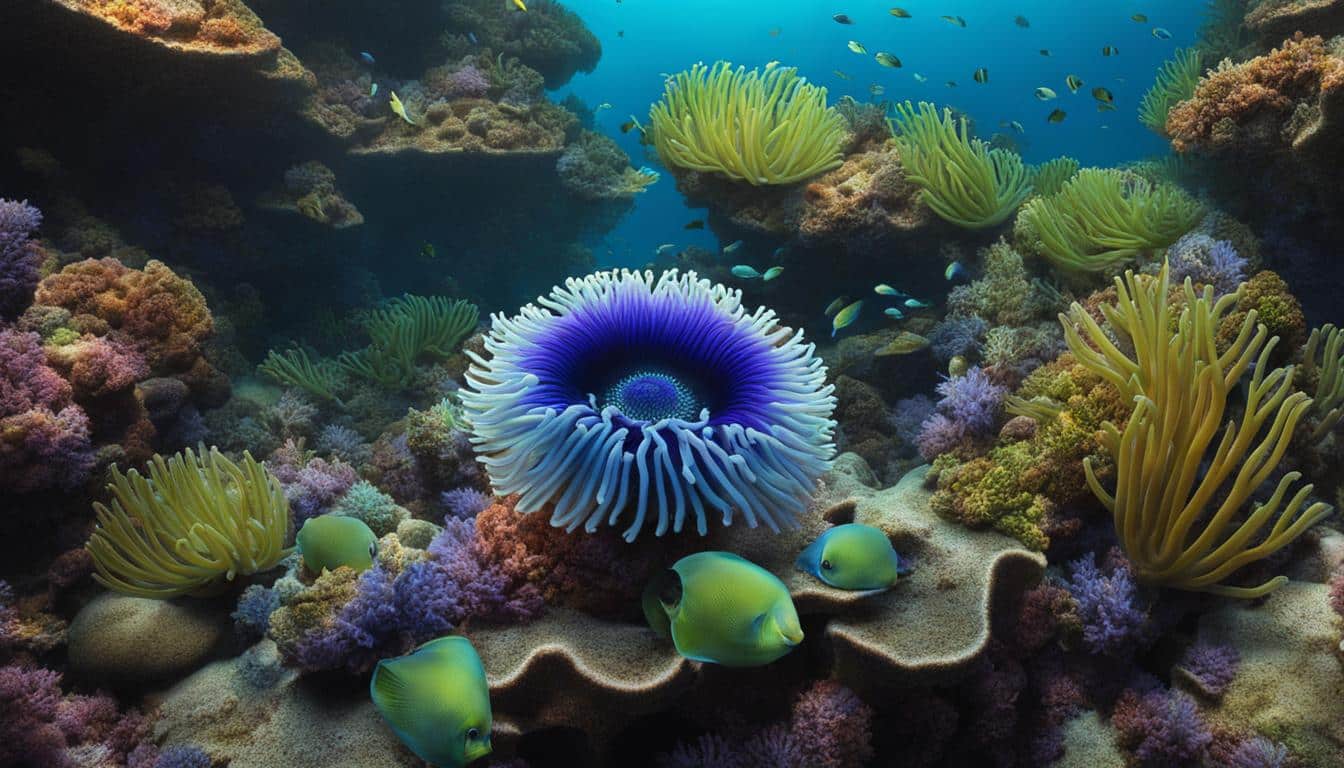Diving Into The Colorful World Of Sea Anemones

Sea anemones are fascinating creatures that exhibit a mesmerizing array of colors. Often mistaken for flowers, these boneless invertebrates belong to the same family as corals and jellyfish. With over 1,000 different species, sea anemones showcase a diverse palette of vibrant hues and patterns. Some even boast unique color variations within their tentacles, creating a captivating sight in the marine world.
Key Takeaways:
- Anemones are predatory invertebrates that display a stunning array of colors
- They belong to the same family as corals and jellyfish
- Sea anemones can exhibit unique color variations within their tentacles
- Their diverse color palettes make them a captivating sight in the marine world
- Exploring anemone care variations allows us to appreciate the wonders of underwater beauty
Characteristics and Behaviors of Sea Anemones
Sea anemones possess unique characteristics and exhibit fascinating behaviors that contribute to their captivating nature. With their three main parts – a pedal disc (base), a cylindrical body, and tentacles – sea anemones showcase an intriguing anatomy. The body of anemones can grow up to six feet in width, while their tentacles are typically equipped with poisonous cells, allowing them to capture and paralyze their prey.
One interesting behavior displayed by sea anemones is flexing locomotion, which enables them to move to new locations. By flexing their bodies, they can detach from their current habitat and glide across surfaces, searching for a more favorable environment. Additionally, sea anemones have the ability to bury themselves in sediments for protection. This behavior helps them camouflage and avoid predators.
Furthermore, sea anemones engage in symbiotic relationships with other marine life forms. One well-known example is the partnership between sea anemones and clownfish. The clownfish find refuge within the anemone’s stinging tentacles, while the anemone benefits from the clownfish’s presence by receiving nutrients from their waste. Another symbiotic association involves sea anemones and green algae, where the algae provides food through photosynthesis while receiving shelter and protection from the anemone.
The characteristics and behaviors of sea anemones contribute to their fascinating nature and make them a subject of interest among marine enthusiasts. The diversity in their anatomy, such as their unique body structure and poisonous tentacles, showcases the remarkable adaptations they have developed over time. Additionally, their fascinating behaviors, from flexing locomotion to symbiotic relationships, add to the allure of these captivating creatures. Understanding the characteristics and behaviors of sea anemones allows us to appreciate the complexity of marine ecosystems and the intricate relationships between different species.

Suggested table:
| Characteristic | Description |
|---|---|
| Body Parts | Consists of a pedal disc, cylindrical body, and tentacles |
| Tentacle Poison | Equipped with poisonous cells for capturing and paralyzing prey |
| Flexing Locomotion | Ability to move by flexing their bodies and detaching from surfaces |
| Burrowing Behavior | Capable of burying themselves in sediments for protection |
| Symbiotic Relationships | Form partnerships with clownfish and green algae for mutual benefits |
Notable Species of Sea Anemones
When it comes to sea anemones, there are several notable species that stand out due to their unique characteristics and stunning colors. Let’s explore some of these fascinating creatures:
Adhesive Sea Anemone
The adhesive sea anemone is found in various coastal regions, particularly in Australia. It gets its name from the sticky substance on its tentacles, which helps it anchor to rocks or coral reefs. This species exhibits a range of vibrant colors, including shades of purple, orange, and green. Its distinct color patterns make it a captivating sight in the underwater world, adding beauty and diversity to marine ecosystems.
Bubble-tip Sea Anemone
The bubble-tip sea anemone is a popular species known for its symbiotic relationship with various fish species, particularly clownfish. It is commonly found in the waters of East Africa. This sea anemone displays a unique coloration, with a light brown body and reddish-colored tips on its tentacles. The vibrant contrast between the body and the tips makes it an eye-catching species, showcasing the intricate bonds between different marine creatures.
Beaded Sea Anemone
The beaded Sea Anemone Color Variations, as the name suggests, has bead-shaped formations along its tentacles. This species exhibits a range of subdued colors, including shades of brown, green, and gray. While its color palette may not be as vibrant as other species, the beaded sea anemone still stands out due to its distinct texture and intriguing bead-like structures. It adds a unique visual element to the underwater world, highlighting the diversity of sea life.
Magnificent Sea Anemone
The magnificent Sea Anemone Color Variations is a true spectacle of colors. It is commonly found in the waters of French Polynesia and is known for its vibrant tentacles and contrasting column colors. The tentacles of this species can display shades of blue, purple, pink, and yellow, creating a stunning visual display. Its vibrant and dynamic appearance makes it one of the most striking sea anemone species, adding a touch of elegance to marine environments.
These notable species of sea anemones exemplify the diversity and beauty found in the underwater world. From the adhesive sea anemone with its captivating colors to the magnificent sea anemone with its mesmerizing tentacles, each species offers a unique visual experience. Exploring anemone color variations allows us to appreciate the wonders of marine life and the intricate relationships between different species.

Conclusion
Exploring the captivating world of Sea Anemone Color Variations reveals a breathtaking display of color variations and fascinating behaviors. Each species, from the adhesive sea anemone to the magnificent sea anemone, offers a unique visual experience that showcases the incredible diversity of marine life.
These vibrant hues and diverse color palettes contribute to the overall beauty of our underwater world. As we delve into the anemone color variations, we gain a deeper appreciation for the intricate relationships between different species that coexist in the ocean.
Whether found in tropical waters or gracing rocky reefs, anemones mesmerize us with their stunning colors. They serve as a reminder of the sheer beauty and wonder that nature has to offer. The marine world truly is a testament to the breathtaking artistry of anemone color variations and the unparalleled beauty of marine life.
FAQ
Are sea anemones actually flowers?
No, sea anemones are not flowers. They are boneless creatures that belong to the same family as corals and jellyfish.
How many different species of sea anemones are there?
There are over 1,000 different species of sea anemones, each with its own unique characteristics and colors.
What are the main parts of a sea anemone?
Sea anemones have three main parts: a pedal disc (base), a cylindrical body, and tentacles.
Are sea anemones poisonous?
Yes, most sea anemones have poisonous tentacles that they use to capture and paralyze their prey.
What are some interesting behaviors exhibited by sea anemones?
Sea anemones display interesting behaviors such as flexing locomotion to move to a new home and burying themselves in sediments for protection.
Do sea anemones have symbiotic relationships with other marine life forms?
Yes, sea anemones exhibit symbiotic relationships with other marine life forms like clownfish and green algae.
What are some notable species of sea anemones?
Some notable species of sea anemones include the adhesive sea anemone, bubble-tip sea anemone, beaded sea anemone, and magnificent sea anemone.
What makes sea anemones so captivating?
Sea anemones captivate us with their stunning colors and remind us of the incredible diversity of nature in the underwater world.



